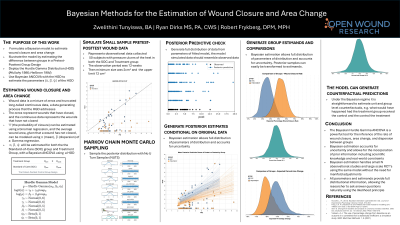Clinical Research
(CR-060) Bayesian Methods for The Estimation of Wound Closure and Area Change
Thursday, May 16, 2024
7:30 PM - 8:30 PM East Coast USA Time

Ryan Dirks, PA-C – Chief Executive Officer, United Wound Healing; Robert Frykberg, DPM, MPH – Chief Research Officer, Open Wound Research
Introduction: In wound care research, a common scientific procedure involves comparing the proportion of closed wounds and the reduction in percentage area between two groups in a pretest-posttest design. Typically, this comparison is made between a Standard of Care (SOC) group and a treatment group or among various treatments. Some less advanced approaches rely on averaging raw percentages for both endpoints. More sophisticated contemporary approaches utilize a combination of null-hypothesis significance testing (NHST) based generalized linear mixed effects models. We present a novel, flexible, and intuitive Bayesian methodology for analyzing these endpoints in two or more groups.
Methods: We use probabilistic programming to build a Bayesian variant of the Hurdle Gamma mixture model (a combination of a logistic binomial and gamma distribution). We provide priors that capture current research and clinical knowledge. We test both real and simulated data with the model and validate using PPC, LOO-CV, and WAIC.
Results: This model accounts for both zero inflation and the fat-tails usually found in wound care data. The model provides full distributional information for all the parameters of the distribution, allowing the likelihood function to capture the full distribution of the endpoints at the posterior mean, and at the full posterior predictive distribution. The model can handle start areas with different means and variance, small samples, different group sample numbers, and provides flexibility for a myriad of comparisons between groups.
Discussion: Bayesian methods offer several advantages in wound care research. They allow for the incorporation of prior knowledge, improving the estimation of complex wound care parameters. Bayesian models provide full probability distributions, enhancing our understanding of uncertainty and variability in wound data. Moreover, Bayesian methods facilitate adaptative research designs, which seamlessly integrate new data, allowing for ongoing updates and refinements in wound care studies. Overall, Bayesian approaches enhance the precision, flexibility, and adaptability of wound care research, ultimately leading to improved wound care research, and ultimately patient outcomes.
Methods: We use probabilistic programming to build a Bayesian variant of the Hurdle Gamma mixture model (a combination of a logistic binomial and gamma distribution). We provide priors that capture current research and clinical knowledge. We test both real and simulated data with the model and validate using PPC, LOO-CV, and WAIC.
Results: This model accounts for both zero inflation and the fat-tails usually found in wound care data. The model provides full distributional information for all the parameters of the distribution, allowing the likelihood function to capture the full distribution of the endpoints at the posterior mean, and at the full posterior predictive distribution. The model can handle start areas with different means and variance, small samples, different group sample numbers, and provides flexibility for a myriad of comparisons between groups.
Discussion: Bayesian methods offer several advantages in wound care research. They allow for the incorporation of prior knowledge, improving the estimation of complex wound care parameters. Bayesian models provide full probability distributions, enhancing our understanding of uncertainty and variability in wound data. Moreover, Bayesian methods facilitate adaptative research designs, which seamlessly integrate new data, allowing for ongoing updates and refinements in wound care studies. Overall, Bayesian approaches enhance the precision, flexibility, and adaptability of wound care research, ultimately leading to improved wound care research, and ultimately patient outcomes.

.jpeg)